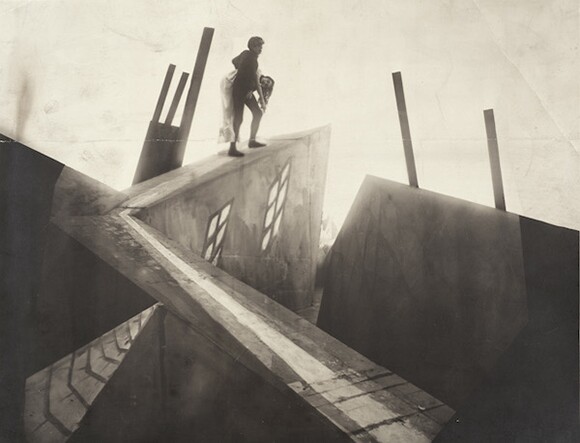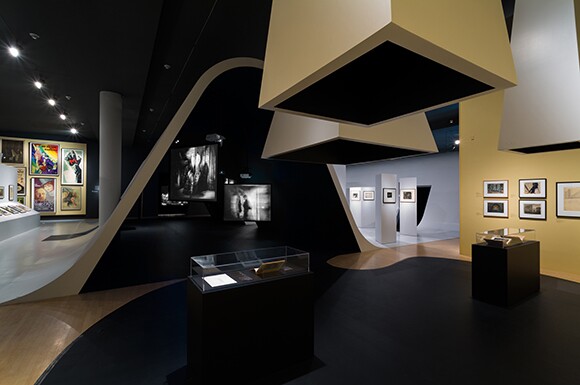Exiles and Expressionism: The Transatlantic Exodus of European Filmmakers

During the 1920s and 1930s, a steady stream of filmmaking talent crossed the Atlantic from Berlin, the center of German-language cinema, to Hollywood. Some were drawn by the blandishments of Hollywood itself -- such as bigger budgets and an international cast of stars -- and some were driven out of Germany by political unrest and the rise of fascism. This included people like directors G. W. Pabst ("Joyless Street," "Pandora's Box") and Fritz Lang ("Metropolis," "M") and actress Marlene Dietrich.
Two exhibitions currently in Los Angeles deal with this troubled but highly productive period of cinema history. One is "Haunted Screens: German Cinema in the 1920s," at Los Angeles County Museum of Art (LACMA) through April 26, 2015, an exhilarating exploration of German Expressionist film of the early 20th century. That movement featured some dark subject matter (murder, madness, mayhem), innovative effects, and chiaroscuro lighting. The exhibition itself has been strikingly designed by architects Amy Murphy and Michael Maltzan, incorporating three interruptive "tunnels" -- two showing film clips on free-floating screens arranged at odd angles, one filled production drawings. Moving through these tunnels is moving from light to dark, and then back again -- an experiential partaking of German Expressionist aesthetics.
The other exhibition is "Light & Noir: Exiles and Emigrés in Hollywood, 1933-1950" at the Skirball Cultural Center (Oct. 23, 2014 - March 1, 2015), and it focusses on the filmmaking talents who fled anti-Semitism in Europe. When the Nazis rose to power in 1933, Jews were banned from the German film industry. During World War II, an estimated 800 German-speaking Jews were working in Hollywood.


Expressionism, of course, did not begin in cinema but in other art forms such as painting and theater in the early 1900s. It rejected realist traditions and sought higher truths -- personal, emotional ones. For the masses, the Expressionist aesthetic was arguably most widely disseminated via film, with such classics as "The Cabinet of Dr. Caligari," "Metropolis," "The Blue Angel," and "M." "I'd say there are two major legacies," says Britt Salvesen, curator of "Haunted Screens" and LACMA's head of photography and prints/drawings departments. "The first has to do with the German Expressionist attention to psychology and their efforts to manifest characters' inner lives not only through writing and acting, but also through all aspects of production design. Secondly, German Expressionist cinema planted the seeds for many of the film genres that continue to thrive today: horror, science fiction, noir."
Some 250 objects tell the story in this exhibition, using still photographs, drawings, posters, film clips, and a few artifacts including a replica of the famous machine robot from "Metropolis" -- the sleek, stylized Art Deco one you so often see reproduced. The production drawings are works of art, not just diagrams or instructions -- they are drawn with off-kilter framing, strong shadows, and distorted perspectives. The tilted shot, called "Dutch" or "German" in the industry, was meant to create malaise, and is famously used, over and over again, in the landmark "The Cabinet of Dr. Caligari" (1920) directed by Robert Wiene.
"Caligari" is often hailed as the first horror film. It is about a mysterious "doctor" and his hypnotized slave who may be involved in a series of local murders. Permeating the film is a contemporary fascination with hypnosis, psychology and the subconscious, and it may also be a comment on the social and political disruption of Germany during the Weimar Republic. Does Dr. Caligari symbolizes the omnipotence and oppression of the state over individuals? As German critic Rudolf Kurtz has said, "Expresssionism isn't an artistic genre but the expression of a world crisis."
For "Caligari, " designer Hermann Warm and painters Walter Reimann and Walter Röhrig created highly theatrical sets, painting shadows directly onto flat panels -- the film is featured in this exhibition with illustrations and clips. Also notable are the set designs of Otto Erdmann for G. W. Pabst's "Street Without Joy" -- they're done in watercolor, with a grayish palette bordering on monochromatic -- and of Andrei Andrejew for several films.



One section of the exhibition is about sound -- often overlooked since "silent films" when shown were not actually silent. They were accompanied by live musicians and sometimes even had a specific score. Another section, in the "tunnel" that's shaped like a ziggurat, is about steps and ladders, and how often they appear in these films. Sometimes they are a grand staircase, such as the one in Fritz Lang's "Metropolis" (1927) that leads disgruntled workers towards the "Heart Machine" which they are intent on destroying, and sometimes they are crude ladders leading to an unknown region outside the frame.
In some ways, "Light & Noir" continues the story, with the German-speaking filmmakers and actors landing in Los Angeles. "It's kind of a metaphor for looking at the émigré experience -- comedy and film noir," says Doris Berger, the exhibition's curator. The émigrés contributed much to both of these genres. "There's the lighter version of looking at life, and the darker version of the looking at life," she says. "All the films we discuss were made by émigré directors. It was not easy to get here to begin with, and then it was not easy to build a new life, a new career."
In one large gallery divided into eight sections, the exhibition begins with a portrait gallery of several dozen of these noted émigrés, including early ones such as Carl Laemmle. Laemmle was a founder of Universal Studios who also helped many compatriots come work in the United States. In addition to photographs, there will be movie posters and props, documents and costumes in this exhibition, much of it from of the Margaret Herrick Library of the Academy of Motion Picture Arts and Sciences.
A little more than half the directors mentioned in the exhibition are Jewish. Sometimes they even managed to make a film with anti-Nazi sentiment, as well as suggest their own plight. Case in point is Michael Curtiz's 1942 film "Casablanca," which gets a section onto itself in the Skirball show. In the film, Rick (Humphrey Bogart) runs a nightclub in Casablanca that is a seething microcosm of wartime politics - and all the exiles it produced. The film would win three Oscars, including Best Picture, and go on to become a classic for its story, characters, lines of dialogue, and famous theme song ("As Time Goes By"). On display are costumes worn by actors Ingrid Bergman and Paul Henreid, props from Rick's Café, and a set of lobby cards. Berger points out that many of the people who worked on the film, both as cast and crew, had been displaced by politics and war in Europe. "By combining social history and film history," she says, "we can see 'Casablanca' in a different way."


Dig this story? Sign up for our newsletter to get unique arts & culture stories and videos from across Southern California in your inbox. Also, follow Artbound on Facebook, Twitter, and Youtube.